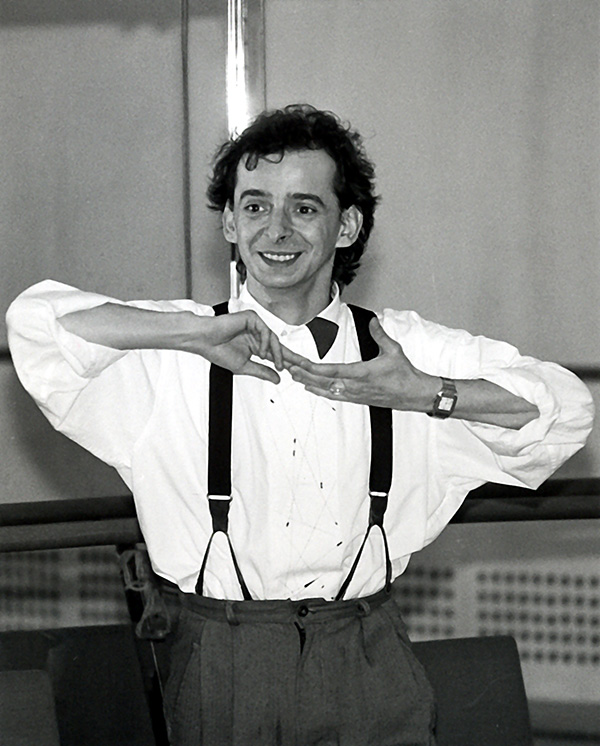
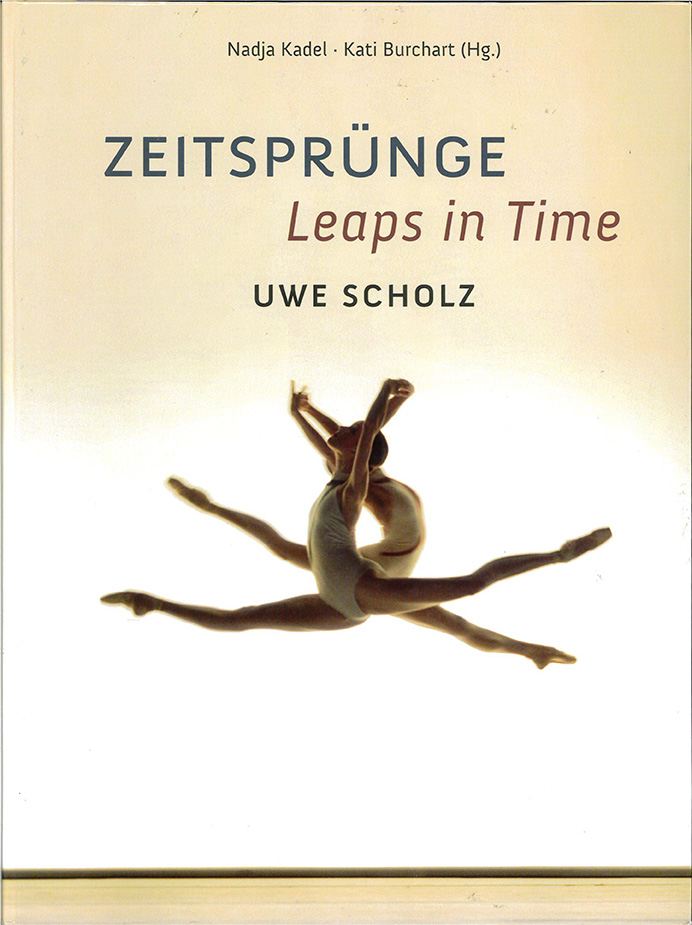
ガブリエレ・ブランドステッターによる紹介、ヴォルクマル・ドレーガーによる作品分析、アーティストへのインタビューを含む、ウヴェ・ショルツの作品に関する初の出版本。
著:Nadja Kadel・Kati Burchart
Octet is one of the most joyful memories of my life, like a first love. It was a very special gift at that time; I was the happiest person alive!
Octetは私の人生の中で、初恋のような楽しい思い出の一つです。その時間はとても特別な贈り物:私は生きている中で一番幸せでした!
Uwe could "sing" movements through the dance like an instrument could express music. His quality of expressing the emotions within the music was very pure. He was trying to push the boundaries of dance, and I learned to take risks and to go beyond what I thought I could do. In this solo, above all, there was a vibrant joy and explosion of movement.
ウヴェは、楽器が音楽を表現するように、ダンスを通して動きを“歌う”ことができました。音楽の中の感情を表現する彼のクオリティーはとても純粋でした。彼はダンスの境界線を押し広げようとし、私はリスクを冒して自分が思っていた以上のことができるようになることを学びました。このソロでは何よりも、きらめく喜びと幾多の動きが炸裂していました。
The pas de deux had a quality of poetic ex-pression through movement. It was not about tech-nique, but rather about presence, vulnerability and expressing feelings through movement – that is what Uwe shared with us in such an inspiring way. The parting at the end was symbolically like saying: "you have left this world and life goes on".
パ・ド・ドゥは、動きによる詩的な表現の質を持っていました。テクニックではなく、存在感、脆弱性、感情を動きで表現することが重要であり、それこそがウヴェの感動的な表現だと思いました。最後のお別れの場面は、象徴的に“あなたはこの世を去ったが、人生は続く”と伝えているようでした
Christine Jaroszewski on "Octet"
クリスティン・ジャロシェフスキが語る“Octet”
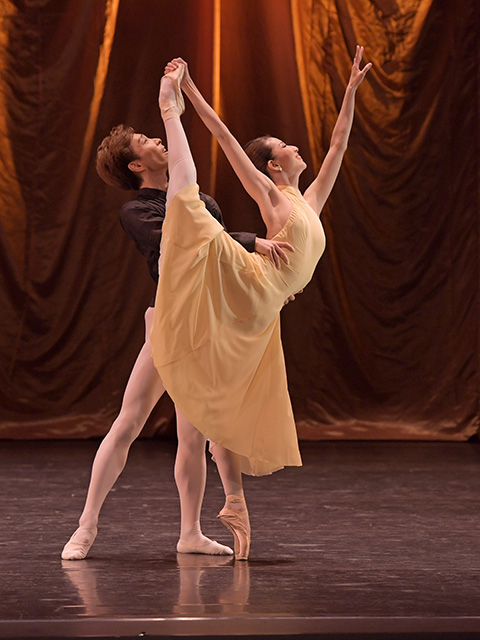
In front of a salmon-coloured drape, gathered up in sections like clouds, six pairs of dancers, four male soloists and a solo pair lose themselves in play, a joyfully spirited game of hide and seek interspersed with contrasting pensive moments. In the first section (Allegro moderato) the pairs cross the scene diagonally in groups of three; first the women, then the men. Their constellations and forms change quickly, often one after the other. For an instant, two pairs nestle up together, yet it seems that at this stage anyone could still fall in love with anyone else. Just as in the music, the choreography works by way of numerous repetitions of themes and sequences. When the men bow down, the women bend over them protectively. From a tight position the men fall onto the ground into the push-up position. Again and again, there are virtuosic solo interludes, acts of courtship and flirting.
サーモンカラーのドレープの前で、雲のように集まった6組のダンサー、4人の男性ソリスト、1組のソロのペアが遊びに没頭します。楽しく元気にかくれんぼゲームをしながら、対照的な物思いにふけっています。第1部(アレグロ・モデラート)では、ペアは3つのグループに分かれて斜めにシーンを横切ります。最初に女性、それから男性の順に。
ペアの配置と姿は急速に変化し、次から次へと変化していく。一瞬、二組のペアが寄り添うが、この段階ではまだ誰もが他の誰かに恋をすることができそうである。振り付けは、音楽と同様に、テーマとシークエンスを何度も繰り返す。男性たちが頭を下げると、女性たちがかばっているかのようにかがむ。男性たちは窮屈な体勢から地面に倒れ込み、腕立て伏せの体勢に入ります。繰り返し、巧みなソロ、求愛の行為、いちゃつく行為が繰り返されます。
The second section (Andante) belongs to the solo couple. In an almost seven-minute pas de deux, the two dancers act out scenes of a relationship. After a long sequence with the female partner led en pointe, typical of Scholz, the counterplay develops out of surrender, then doubt and self-questioning. As the man tries to stroke her face, she eludes him. With her arms stretched out longingly before her, she ap-proaches him — and fails to clasp him. After the em-brace at the beginning, the lovers now step past one another: full of grief, she follows him with her gaze.
第2部(アンダンテ)はソロのカップルの幕。約7分間のパ・ド・ドゥでは、二人のダンサーが交際の場面を演じています。ショルツの典型的なポワントに導かれた女性のパートナーとの長いシークエンスの後、カウンタープレイは降伏から始まり、後に疑心暗鬼と自問自答へと発展していく。男性が女性の顔を撫でようとすると、女性は男性から逃げ出す。女性は両腕を前に長く伸ばしたまま、男性に近づきますが、男性を抱きしめることはできない。冒頭の抱擁の後、恋人たちはお互いにすれ違う、悲しみに満ちた女性の視線は男性を追いかけます。
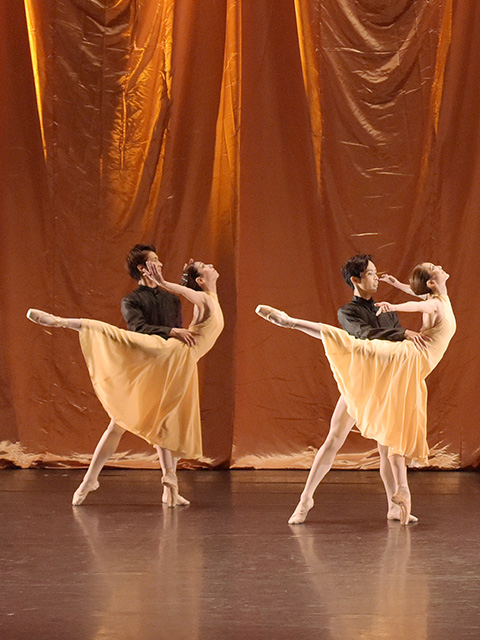
The third section (Scherzo) is dedicated to the theme of friendship. Several times, one of the four men pulls himself clear of the trio into a solo position, copying their jumps, just as they imitate his pirouettes. Clustering tightly together, they form an inverse bell shape, before resuming their joyful fraternizing. "And what of it", the last man seems to be saying as his friends run off.
第3部(スケルツォ)のテーマは友情。何度か、4人のうちの1人がトリオから離れてソロのポジションに入り、彼らのジャンプを真似る。と同時に彼らは彼のピルエットを真似する。彼らは再び楽しく交る前に、集まり、逆さのベルのような形を作る。そして、最後に残った男性は、友人達が走り去っていく中「それで?」と言っているかのようだった。
The fourth section (Presto) picks up the theme of what the happy pairs are doing at an accelerated pace and a dazzlingly technical level: diagonal and line formations, lifts and carries, folkloric games of teasing and twisting between two men and a woman. The solo pair sheers off, and the male soloist also goes on his way; after bowing artfully to one another, the male and female dancers step out of the row and exit in opposite directions.
第4部(プレスト)では、幸せなペアの幕。ペアは加速したペースで、目もくらむようなテクニックを披露:対角線とラインのフォーメーション、リフトとキャリー、2人の男性と1人の女性が絡み合う民俗ゲームを披露。ソロ・ペアは、はけて行き、男性ソリストも去っていく。丁寧にお辞儀をした後、男性と女性のダンサーは列を離れて反対方向に退場していきます。
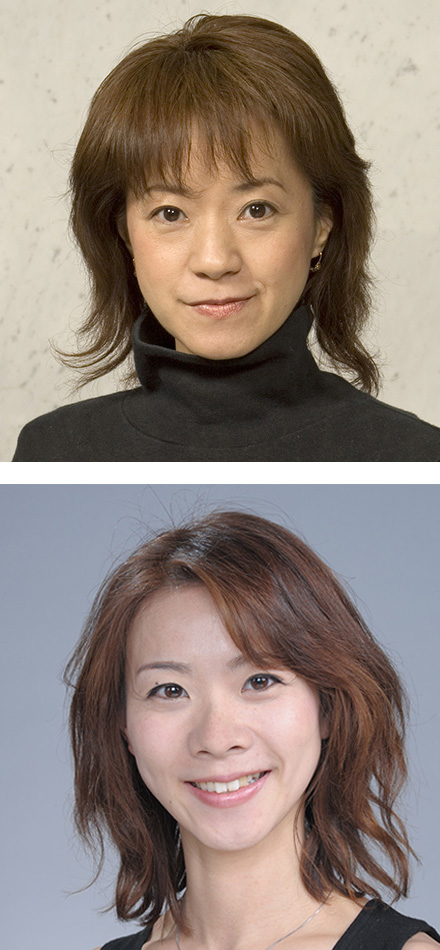
山口智子 Tomoko Yamaguchi
若林美和 Miwa Wakabayashi
オクテットは各楽章に異なるドラマがあり、大人っぽい雰囲気の洗練された作品です。テクニックをこなすだけではなく、心から感じ、全身を使って音楽を表現することが求められます。
ジョヴァンニ先生のご指導を受け、ダンサー自身が真摯に自分と作品に向き合い、自分の為だけではなくお客様に喜んで頂ける踊りを披露できるように、日々練習を重ねております。
東京シティ・バレエ団では4回目のオクテットとなりますが、キャストも変わりまた新たな魅力を観せてくれることでしょう。どうぞご期待下さい。
音楽:F.メンデルスゾーン 「弦楽八重奏曲」変ホ長調 Op.20
衣裳製作:工房いーち
初演:チューリッヒ・バレエ団(1987年)
日本初演:東京シティ・バレエ団(2017年)
バレエミストレス:山口智子 若林美和
| 第1楽章 | 中森理恵
キム・セジョン 平田沙織 飯塚絵莉 渡邉優 植田穂乃香 斎藤ジュン 内村和真 土橋冬夢 吉野壱郎 吉岡真輝人 福田建太(23日)/ 吉留諒(24日) |
|---|---|
| 第2楽章 | 清水愛恵 濱本泰然 |
| 第3楽章 | 吉留諒(23日)/ 福田建太(24日) 岡田晃明 渡部一人 栄木耀瑠 |
| 第4楽章 | 中森理恵
キム・セジョン 吉留諒(23日)/ 福田建太(24日) 平田沙織 飯塚絵莉 渡邉優 植田穂乃香 斎藤ジュン 山本彩未 内村和真 土橋冬夢 吉野壱郎 吉岡真輝人 杉浦恭太 福田建太(23日)/ 吉留諒(24日) |
※出演者は変更となる場合がございます。